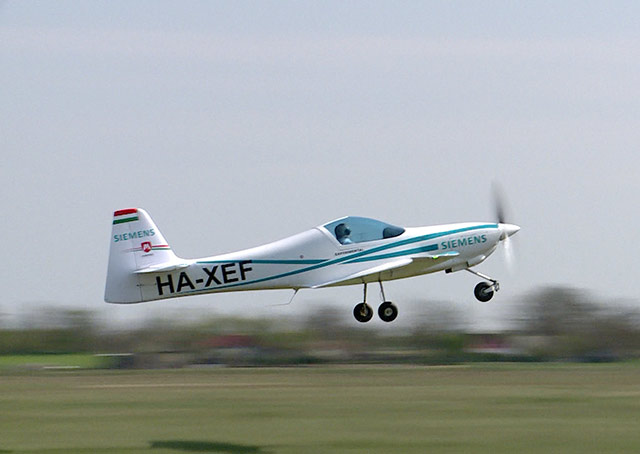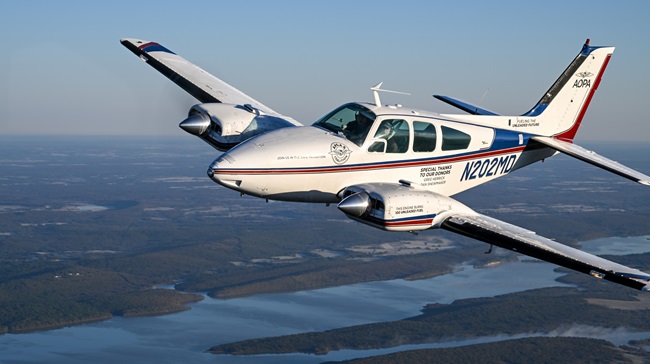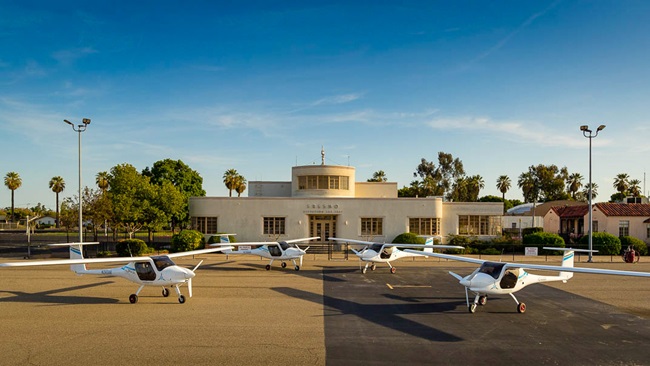
The all-electric Magnus eFusion two-seat airplane may play a dual role in aviation—an efficient upset recovery training aircraft and a test bed for a battery system for electric powerplant manufacturer Siemens.
The composite airplane made its first flight on April 11 in Hungary and was first seen at AERO Friedrichshafen in Germany on April 20. The 60-kilowatt motor with the potential for bursts to 85 kw was built by Siemens, parent company of Magnus Group, which built the airplane.
“The maiden flight of the eFusion is another important milestone in electric aviation,” said Frank Anton, head of eAircraft at Siemens. “The aircraft will serve as a flying test bed for our further battery system optimization.” In addition though, the airplane may be put into serial production as a light aerobatic airplane.
Siemens was also showing a more capable aerobatic machine, an Extra 330L with a 260 kw motor, equivalent to about 330 to 340 horsepower, according to Anton. He suggested an airplane with two or three such motors could someday serve as an airliner of about 19 seats. Extra, meanwhile, has yet to fly the airplane. The motor is mounted just behind the propeller with the space aft of that and ahead of the firewall packed full of high-performance batteries. Anton suggested the Extra 330 with those batteries would have about 20 minutes of endurance, including five minutes at maximum power—enough time to take off, climb to an aerobatic box, loiter for a few minutes, perform a maximum effort route, return to the airport, go around if needed, and land safely. An Extra official said the high-torque motor may allow for maneuvers not otherwise possible.

While the all-electric airplanes are useful for specific missions, such as aerobatics or flight training, most of Siemens’ efforts are focused on hybrid electric solutions, pairing a petroleum-powered engine with an electric motor, according to Anton. The motor could provide additional power for takeoff and then be recharged in flight by the engine. The result would be fewer emissions, lower fuel burn, and potentially less noise.
An example of that concept was the Hypstair, also on display at AERO. It is a Siemens motor paired with a Rotax 914 engine in a mockup of a Pipistrel Panthera airframe. No word on when that might fly. You may recall that Pipistrel and Siemens had a bit of a dust-up last year when Siemens reportedly yanked its motor from a Pipistrel set to be the first electric airplane to cross the English Channel. Siemens instead was supporting a crossing by its then new partner Airbus on the innovative all-electric E-Fan airplane, a two-seater designed as a trainer.
A Siemens spokesman told AOPA at AERO that Pipistrel and Siemens have since worked out their relationship.
Meanwhile, earlier this month Airbus and Siemens signed a partnership designed to demonstrate by 2020 the feasibility of hybrid electric propulsion and the “electrification of aviation.”
“We believe that by 2030 passenger aircraft below 100 seats could be propelled by hybrid propulsion systems,” said Tom Enders, CEO of Airbus Group, in a statement issued after the announcement.



